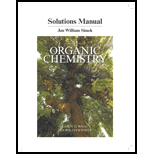
Concept explainers
(a)
To determine: The products, when
Interpretation: The products, when
Concept introduction: Hydroboration-oxidation reactions convert an alkyne molecule into
An acid catalysed hydration reaction of
(b)
To determine: The products, when
Interpretation: The products, when
Concept introduction: Hydroboration-oxidation reactions convert an alkyne molecule in to ketone or aldehyde in the presence of disiamylborane and hydrogen peroxide through the two step mechanism, whereas an alkene molecule in hydroboration-oxidation reaction is converted into alcohol by the addition of water.
An acid catalysed hydration reaction of alkynes in the presence of mercuric sulphate gives ketone.
(c)
To determine: The products, when
Interpretation: The products, when
Concept introduction: Hydroboration-oxidation reactions convert an alkyne molecule in to ketone or aldehyde in the presence of disiamylborane and hydrogen peroxide through the two step mechanism, whereas an alkene molecule in hydroboration-oxidation reaction is converted into alcohol by the addition of water.
An acid catalysed hydration reaction of alkynes in the presence of mercuric sulphate gives ketone.
(d)
To determine: The product, when
Interpretation: The products, when
Concept introduction: Hydroboration-oxidation reactions convert an alkyne molecule in to ketone or aldehyde in the presence of disiamylborane and hydrogen peroxide through the two step mechanism, whereas an alkene molecule in hydroboration-oxidation reaction is converted into alcohol by the addition of water.
An acid catalysed hydration reaction of alkynes in the presence of mercuric sulphate gives ketone.
Want to see the full answer?
Check out a sample textbook solution
Chapter 9 Solutions
Student's Solutions Manual for Organic Chemistry
- Hi, I need your help i dont know which one to draw please. I’ve attached the question along with my lab instructions. Please use the reaction from the lab only, as we are not allowed to use outside sources. Thank you!arrow_forward5. Write the formation reaction of the following complex compounds from the following reactants: 6. AgNO₃ + K₂CrO₂ + NH₄OH → 7. HgNO₃ + excess KI → 8. Al(NO₃)₃ + excess NaOH →arrow_forwardIndicate whether the product formed in the reaction exhibits tautomerism. If so, draw the structure of the tautomers. CO₂C2H5 + CH3-NH-NH,arrow_forward
- Draw the major product of this reaction N-(cyclohex-1-en-1-yl)-1-(pyrrolidino) reacts with CH2=CHCHO, heat, H3O+arrow_forwardDraw the starting material that would be needed to make this product through an intramolecular Dieckmann reactionarrow_forwardDraw the major product of this reaction. Nitropropane reacts + pent-3-en-2-one reacts with NaOCH2CH3, CH3CHOHarrow_forward
- Indicate whether the product formed in the reaction exhibits tautomerism. If so, draw the structure of the tautomers. OC2H5 + CoHs-NH-NH,arrow_forwardExplain how substitutions at the 5-position of barbituric acid increase the compound's lipophilicity.arrow_forwardExplain how substitutions at the 5-position of phenobarbital increase the compound's lipophilicity.arrow_forward
- Name an interesting derivative of barbituric acid, describing its structure.arrow_forwardBriefly describe the synthesis mechanism of barbituric acid from the condensation of urea with a β-diketone.arrow_forwardGiven the hydrazones indicated, draw the structures of the enamines that can be formed. Indicate the most stable enamine (explain). C6H5 C6H5 H C6H5 Harrow_forward
 ChemistryChemistryISBN:9781305957404Author:Steven S. Zumdahl, Susan A. Zumdahl, Donald J. DeCostePublisher:Cengage Learning
ChemistryChemistryISBN:9781305957404Author:Steven S. Zumdahl, Susan A. Zumdahl, Donald J. DeCostePublisher:Cengage Learning ChemistryChemistryISBN:9781259911156Author:Raymond Chang Dr., Jason Overby ProfessorPublisher:McGraw-Hill Education
ChemistryChemistryISBN:9781259911156Author:Raymond Chang Dr., Jason Overby ProfessorPublisher:McGraw-Hill Education Principles of Instrumental AnalysisChemistryISBN:9781305577213Author:Douglas A. Skoog, F. James Holler, Stanley R. CrouchPublisher:Cengage Learning
Principles of Instrumental AnalysisChemistryISBN:9781305577213Author:Douglas A. Skoog, F. James Holler, Stanley R. CrouchPublisher:Cengage Learning Organic ChemistryChemistryISBN:9780078021558Author:Janice Gorzynski Smith Dr.Publisher:McGraw-Hill Education
Organic ChemistryChemistryISBN:9780078021558Author:Janice Gorzynski Smith Dr.Publisher:McGraw-Hill Education Chemistry: Principles and ReactionsChemistryISBN:9781305079373Author:William L. Masterton, Cecile N. HurleyPublisher:Cengage Learning
Chemistry: Principles and ReactionsChemistryISBN:9781305079373Author:William L. Masterton, Cecile N. HurleyPublisher:Cengage Learning Elementary Principles of Chemical Processes, Bind...ChemistryISBN:9781118431221Author:Richard M. Felder, Ronald W. Rousseau, Lisa G. BullardPublisher:WILEY
Elementary Principles of Chemical Processes, Bind...ChemistryISBN:9781118431221Author:Richard M. Felder, Ronald W. Rousseau, Lisa G. BullardPublisher:WILEY





